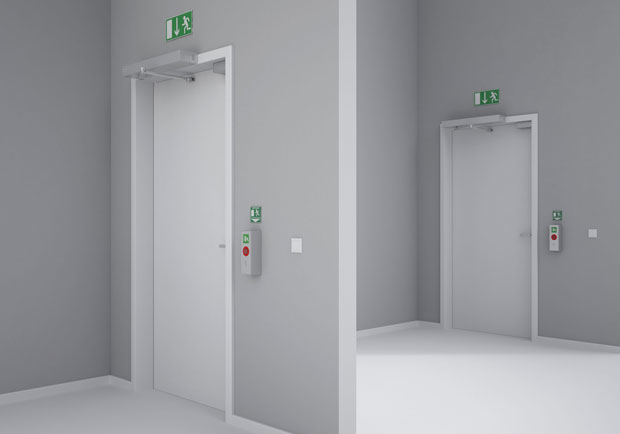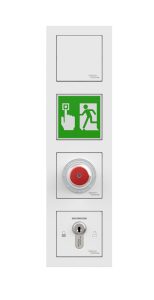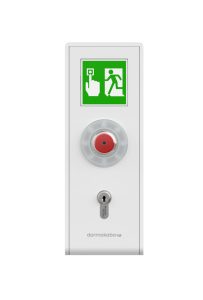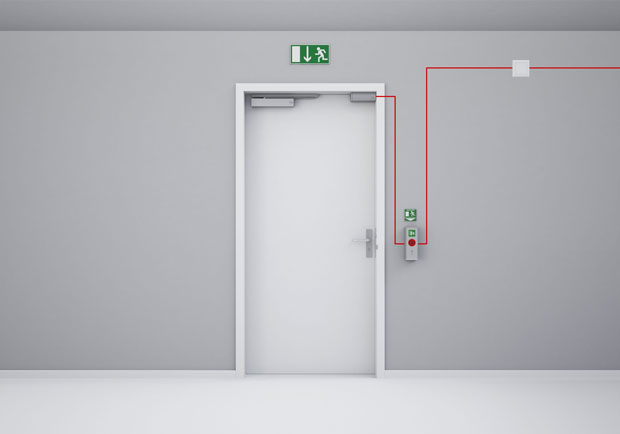When it comes to door hardware, balancing safety and security can be a challenge. dormakaba’s new SafeRoute emergency exit and escape route system has been developed to provide enhanced security while still ensuring safe and efficient evacuation in an emergency.
One of the key issues is that doors that form part of an escape route must also prevent unauthorised access and need to be secured with an electrically controlled locking system. The typical solution to meeting both requirements is to use emergency escape locks with automatic self-locking mechanisms. This allows the door to be opened easily from the inside during an emergency situation, but it locks again as soon as the door closes, preventing unauthorised access from outside. However, this approach does not prevent misuse of the emergency exit.
This misuse can take different forms depending on the type of building. In a retail environment the emergency exit could be used as a getaway route out of the building for thieves. In care homes, hospitals and educational and child-care settings the emergency exit is a potential way for vulnerable people to leave without supervision. In workplaces it may be that employees misuse the emergency exit doors as an alternative exit from the building in a non-emergency situation.
dormakaba’s SafeRoute system helps to solve these issues. SafeRoute is BS EN 13637 compliant, the standard for electrically controlled exit systems used on escape routes. It can be applied to single doors, groups of up to four doors connected to a single control unit, or as a network solution for larger buildings. SafeRoute is also compliant with fire door standards so it can be used on all doors on the escape route, including certified fire doors.
One of the ways that SafeRoute helps prevent misuse is through its delayed egress function. This allows a time delay between the user pressing the emergency exit button and the release of the door. In the case of preventing theft, this delay allows security personnel to reach the thief before they can leave. Similarly, with children and vulnerable adults leaving unsupervised, the time delay means those caring for them have time to prevent them leaving.
In addition, the SafeRoute system can help prevent non-emergency use of the door. Through a central management control (CMC), SafeRoute provides real time alerts when an emergency exit is activated to provide a warning of unauthorised use. The CMC also allows building operators to view the status of each door connected to the system and to lock or unlock individual or groups of doors remotely.
SafeRoute provides additional functionality for specific types of building. For secured areas, such as staff areas of airports, an escape route may include a series of access controlled doors that must be released in an emergency. Standalone door releases can prove impractical and can slow the evacuation. SafeRoute enables a predetermined series of doors to be released in an emergency to allow swifter evacuation but with final external door or exit into the public area still secured, which can be released as needed.
In addition, for areas where clinical hygiene must be maintained, such as for operating theatre entrances and clean rooms, SafeRoute can be used to create an airlock system on an escape route. In normal use, one door can only be opened if the other is closed and locked.
For large buildings used by the public, such as music, sports and entertainment venues, people will likely be unfamiliar with the layout and escape routes, making safe and swift evacuation a challenge. SafeRoute enables the emergency exit doors to all be released using the CMC, or automatically when a fire is detected. SafeRoute also integrates with other parts of the building’s security and access system, such as turnstiles and speed gates. This allows these to be released in an emergency to streamline evacuation further. In addition, with motorised door operators fitted to internal escape route doors, SafeRoute allows these to be opened automatically for barrier free evacuation.
SafeRoute has been designed to enable easy and straightforward installation and the system’s preconfigured parameters are suitable for many applications to make commissioning simple. Where the standard parameters are not fully suitable, further customisation can be made with the TMS Soft® door management software. The flexible subscription-free licencing model ensures SafeRoute is cost effective for buildings of all sizes. The functions of the system are determined by the licence card inserted into the SafeRoute Control Unit (SCU). Facilities managers can simply purchase the options that best meet their needs. If necessary, the system can be upgraded with additional functions by swapping the cards in the unit, with no need for hardware changes.
dormakaba’s SafeRoute system provides a solution to ensuring safe and efficient evacuation in an emergency while delivering enhanced security during day-to-day use that complies with the regulations. To find out more about SafeRoute visit www.dormakaba.com/gb-en/saferoute-escape-route.
-ends-
The view or information contained within these unedited press releases, are that of the company producing it and not necessary the views of kpm.








